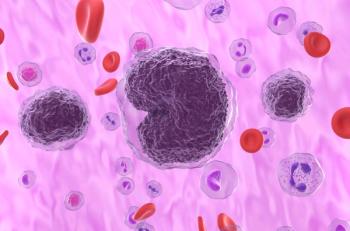
How AI Can Live Up to the Hype in Hematology
Key Takeaways
- AI is being leveraged in hematology for image analysis and biomarker prediction, with slow uptake of regulator-approved devices but significant "shadow use" of nonapproved applications.
- AI agents may automate tumor boards or prescribe treatments, with legislative developments suggesting this possibility is closer to reality than assumed.
Sessions and posters at the 2025 European Hematology Association Congress evaluated the potential and real-world practices of using artificial intelligence (AI) to predict and improve outcomes for patients with hematological diseases.
Opportunities, Pitfalls, and Bringing AI Into Practice
On Friday, June 13, a lecture closing out the first presidential session of the congress took the audience through the journey of AI in health care to the present day.1 According to Jakob Nicholas Kather, MD, MSc, of the Technical University of Dresden and University Hospital of Dresden, “we are living in a time of AI hype,” but some may recall this is not the first time. Back in 2012, a huge amount of excitement surrounded the potential of IBM’s Watson tool to transform medical problem-solving, but its promises did not pan out. In 2023, the arrival of ChatGPT changed everything—it’s now so prevalent that “your children are using this to do their homework,” Kather said.
Looking at government statements announcing large financial investments in AI, the most common justification is health care, so “we as medical doctors are responsible for materializing the benefit of these huge investments to our society through application of artificial intelligence in health care,” Kather noted, and as such clinicians and researchers will need to be literate in this technology and lead its implementation.
Specific to hematology, AI is being leveraged for image analysis in bone marrow diagnostics and prediction of biomarkers, and
The wave of the future for AI-enabled hematology, according to Kather, will be AI agents, which combine large language models with external tools or software, eventually perhaps automating a tumor board or allowing AI to prescribe treatment. Kather noted this possibility is closer to reality in the legislative sense than most would assume, with a bill recently introduced in the US House of Representatives that would
Of course, AI models have the potential to malfunction or hallucinate, and their use in health care must be even more conservative and risk-averse than in other fields. But even with this cautious approach, and “even if we assume that technology will not evolve at all, just taking existing models and improving them in workflows in health care and validating them will unlock tremendous benefits,” Kather concluded.
AI in Ghost Cytometry, APL Assessment, and MDS Biomarkers
Posters presented at EHA yielded insights on how the use of AI is already transforming clinical practice. One abstract by researchers from Juntendo University in Japan described how AI-driven “ghost cytometry” enabled early diagnosis of chronic myeloid leukemia and prediction of treatment response.4 By combining flow cytometry and AI to enhance cell discrimination performance, the approach was able to distinguish between peripheral leukocytes from patients with CML and healthy participants with an F1 score of 0.79. The authors hope that ghost cytometry–derived morphological information “may predict early treatment response and DMR [deep molecular response] achievement, which may help in choosing TKIs [tyrosine kinase inhibitors].”
Another poster, presented by researchers from Carol Davila University in Romania, described the results of a systematic review of the literature of AI’s potential in assessing acute promyelocytic leukemia.5 They found that AI models successfully interacted with -omics data, blood samples, cytomorphology, and flow cytometry results with impressive sensitivity, specificity, and accuracy. For instance, area under the receiver operating characteristic curve was 96% and 95% when based on peripheral blood smears and on bone marrow aspirate smears, respectively.
Finally, investigators using a data set from the International Consortium for MDS analyzed molecular predictors of patient benefit from hypomethylating agents for higher-risk myelodysplastic syndrome (MDS).6 Using advanced AI-based methods, they generated clusters based on cytogenetic and molecular profiles, which they hope provides “a foundation for targeted therapeutic strategies and patient management.” Next steps will be to incorporate nongenetic factors (eg, immune changes) into the predictive models to improve stratification and potentially guide enrollment in clinical trials.
References
1. Kather JN. Artificial intelligence in hematology: Opportunities, pitfalls and how to bring it to clinical practice. Presented at: EHA 2025 Congress; June 13, 2025; Milan, Italy.
2. Lång K, Josefsson V, Larsson AM, et al. Artificial intelligence-supported screen reading versus standard double reading in the Mammography Screening with Artificial Intelligence trial (MASAI): a clinical safety analysis of a randomised, controlled, non-inferiority, single-blinded, screening accuracy study. Lancet Oncol. 2023;24(8):936-944. doi:10.1016/S1470-2045(23)00298-X
3. Healthy Technology Act of 2025, HR 238, 119th Cong (2025). Accessed June 15, 2025.
4. Suzuki K, Watanabe N, Yamada K, Ando M, Takaku T. Artificial intelligence–driven ghost cytometry enables label-free detection of leukemic cells and treatment resistance prediction in chronic myeloid leukemia. Presented at: EHA 2025 Congress; June 12-15, 2025; Milan, Italy. Abstract PS2306.
5. Găman MA, Dugaesescu M, Popescu DC. Towards the use of artificial intelligence models in the assessment of acute promyelocytic leukemia – systematic review. Presented at: EHA 2025 Congress; June 12-15, 2025; Milan, Italy. Abstract PS1534.
6. Lanino L, Kewan T, Bewersdorf J, et al. Artificial intelligence-enhanced analysis of HMA treatment on clinical outcomes in a large cohort of MDS patients: preliminary results from an analysis from the International Consortium for MDS (icMDS) VALIDATE database. Presented at: EHA 2025 Congress; June 12-15, 2025; Milan, Italy. Abstract PF636.
Newsletter
Stay ahead of policy, cost, and value—subscribe to AJMC for expert insights at the intersection of clinical care and health economics.













































